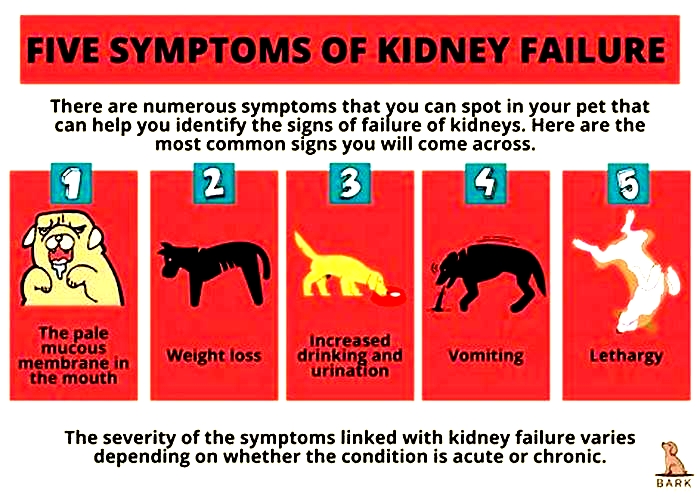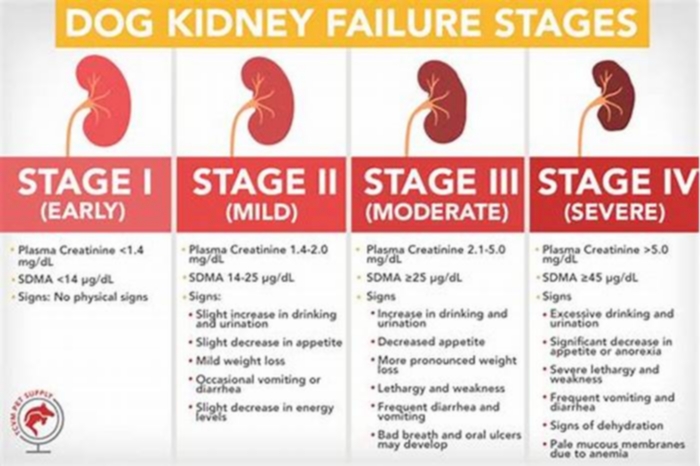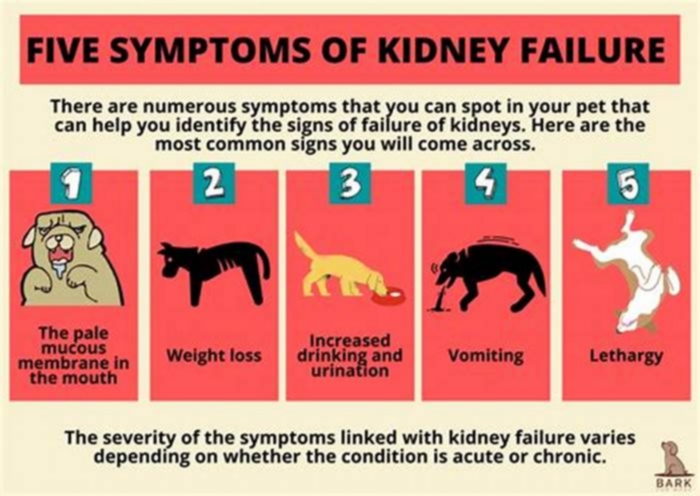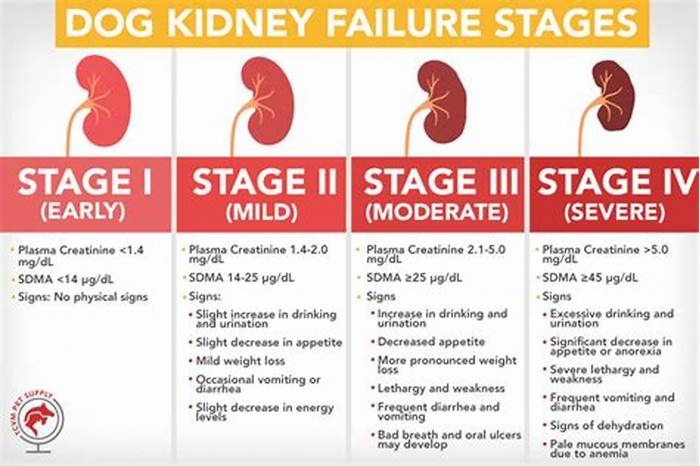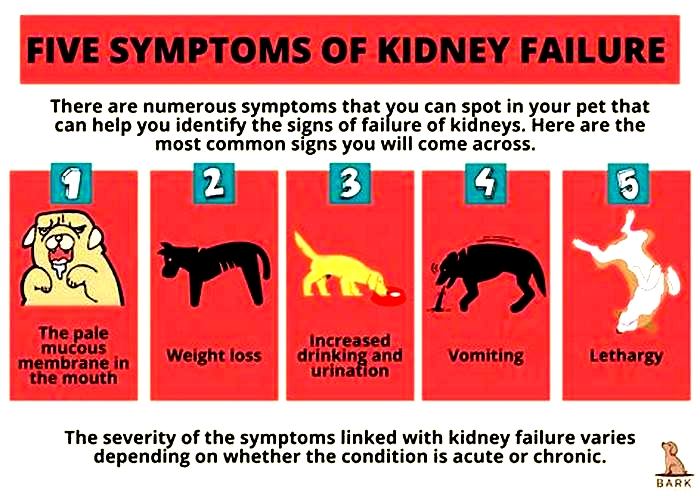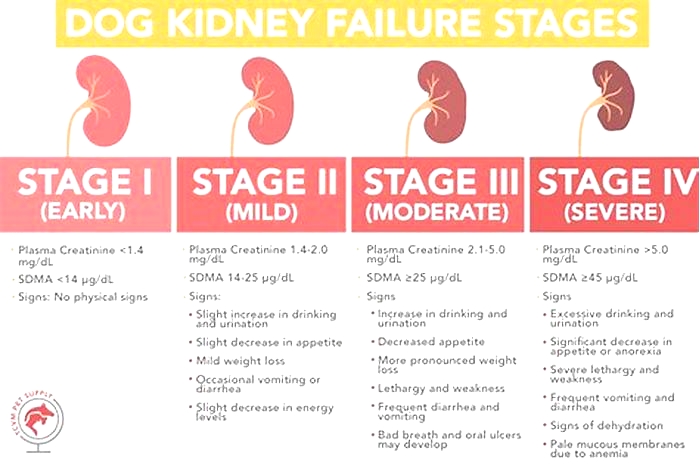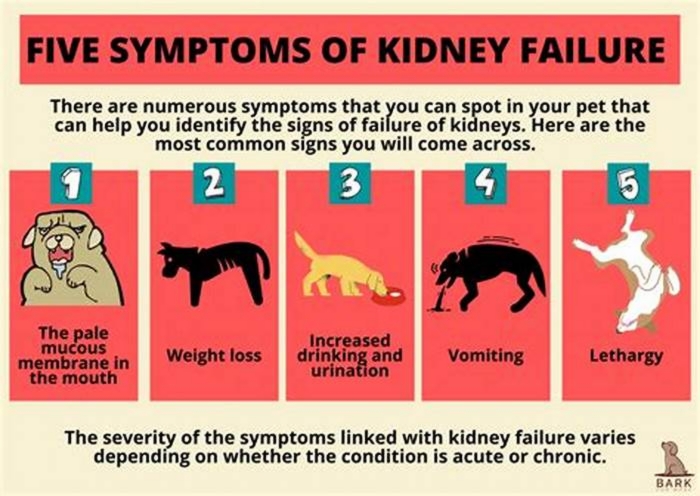kidney failure dogs signs
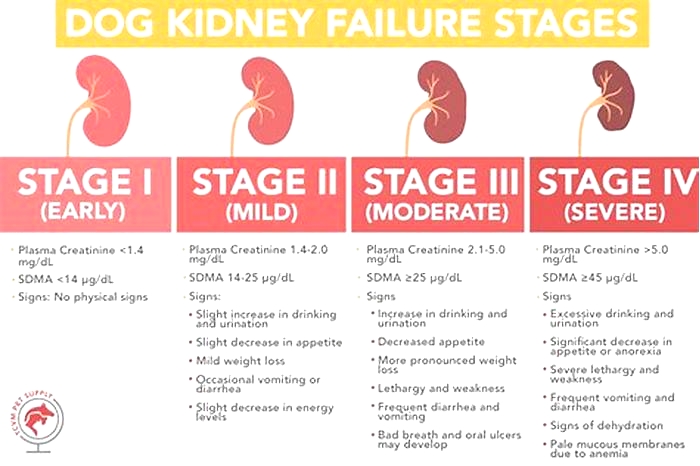
Kidney Failure in Dogs
Types of Kidney Failure in Dogs
There are two types of kidney failure in dogs - acute kidney failure and chronic kidney failure.
Acute kidney failure occurs when there is a sudden decline in kidney function (within hours or days) as a result of toxin exposure (such as antifreeze, raisins, grapes, and some human medications) and bacterial infection.
On the other hand, chronic kidney failure involves a gradual but progressive loss of kidney function. The problem can take weeks, months, or years to develop. Age-related issues are the topmost reasons for kidney failure in dogs. Deterioration of organ structure and function inevitably occur from years of wear and tear.
The size of the dog has been found to influence the age of onset of chronic kidney disease. Early signs of kidney disease in smaller dog breeds may be exhibited when theyre about 10-14 years of age. On the other hand, larger breeds, which are known to have shorter life spans than their smaller counterparts, may develop kidney failure as early as seven years old.
Acute Kidney Failure in Dogs
Signs of Acute Kidney Failure
Dogs with acute kidney failure typically show signs of severe lethargy, vomiting, and reduced appetite. They may be drinking and urinating a lot or not at all.
Causes of Acute Kidney Failure
- One of the most common causes of acute kidney failure in dogs is ingestion of toxins, such as antifreeze, rodenticides, or some human medications (such as ibuprofen). Dogs are such curious creatures and this trait can increase their risks for toxin exposures.
- Infection with a bacterial organism called Leptospirosis can lead to kidney failure in pets and people.
- Various drugs can also cause kidney failure in certain pets.
- Severe infections or illnesses like sepsis or pancreatitis can also lead to acute kidney failure.
- Obstruction of the urinary tract caused by kidney stones or bladder stones that restricts urine flow.
- Anything that decreases the flow of blood through the kidneys, including dehydration, heatstroke, bee stings, or snake bites.
Treatment of Acute Kidney Failure
Acute kidney failure is a serious condition. Aggressive and quick treatment to support the kidneys and manage the underlying cause can be lifesaving. Treatment typically consists of hospitalizing your dog and keeping them on IV fluids, administering anti-nausea medications, administering antibiotics if needed, and ensuring they receive proper nutrition. The treatment may take days to weeks. Rechecking blood work and urine tests will help your vet monitor your dogs response to treatment.
Acute kidney failure can be fatal in over half the cases, even with treatment. Approximately 20% will recover and have chronic kidney disease as a result of the damage and 20% will recover and regain normal kidney function.
Chronic Kidney Failure in Dogs
Older cats are more prone to developing chronic kidney failure compared to dogs, but dogs can also develop this condition. Since this is a slow, progressive process, your dog may not show symptoms immediately. You may notice weight loss or muscle mass loss even though your dog is eating well. You might also notice your dog drinking and urinating more than usual. Its important to note that diabetes can cause similar symptoms.
Diagnosing Chronic Kidney Failure
Early stages of chronic kidney disease can be diagnosed with routine yearly blood work and urine tests before clinical symptoms even develop. If your vet suspects kidney failure, they will recommend basic blood work, urinalysis (urine test), and blood pressure measurements to help diagnose kidney failure, stage the kidney failure, and discuss proper treatments and supportive care.
Kidney failure is staged in 4 levels, with Stage 1 being the mildest and Stage 4 being the most severe.
Treatment for Chronic Kidney Failure
Once your vet has diagnosed and staged your dogs kidney failure, treatment will be discussed. Options can range from medications that lower blood pressure, treatment to reduce protein loss in the urine, intravenous or subcutaneous fluids, potassium replacement, medications to help improve red blood cell levels, and dietary changes.
There are a variety of prescription kidney supportive diets available. These diets can help your dog feel better and live longer, often for years, depending on the stage of kidney failure your dog is experiencing. Since some dogs can be picky eaters, you may need to try a variety of diets to find one they enjoy, so dont be discouraged if they refuse a few types!
Encouraging your dog to drink more water will also help support the kidneys. Canned foods contain more fluids compared to dry kibble, so feeding your dog canned food and eliminating the kibble may be recommended. Adding water or low sodium chicken broth (avoid onions and garlic) to the food can also encourage more water intake. Having multiple water bowls around the house will make it easier for your senior dog to take a drink when they want to.
Home Care for Dogs with Kidney Failure
If your dog has been diagnosed with chronic kidney disease, here are some ways to help your dog have a better and longer life:
- Prescribed medications should be administered exactly as instructed by your veterinarian.
- Keep a close eye on your dogs diet and food intake. If your pet is on a prescription diet, avoid feeding extra treats or snacks.
- Divide your dogs daily ration into several smaller meals given at regular intervals throughout the day.
- Fresh food should always be offered during each mealtime.
- Fresh clean water should be available to the dog at all times.
- If your dog has a poor appetite, try warming the food to just below body temperature. Warming can enhance the taste and flavor of the food and encourage your pet to eat.
- Regular monitoring is very important. Dont skip your pets appointments with your veterinarian for follow-up exams and lab work
Read more:
Urinary Tract Infection (UTI) in Dogs
Canine Hormone-Responsive Urinary Incontinence
My dog has Cushings disease. What does this mean?
Need to speak with a veterinarian regarding your dogs kidney disease or another condition?
Click here to schedule a video consult to speak to one of our vets. You can also download the FirstVet app from the Apple App Store and Google Play Stores.
Kidney Failure In Dogs: Causes, Symptoms & Treatment Options
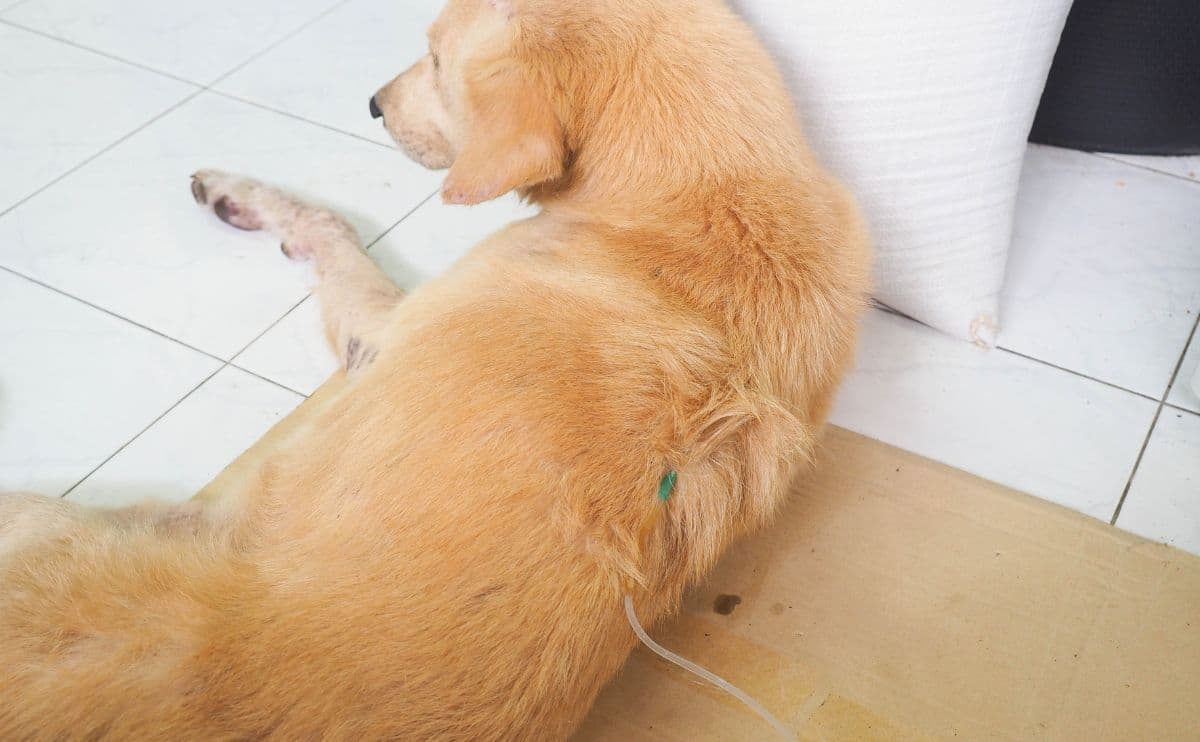
Kidney disease in dogs is a scary diagnosis for pet parents. After all, we want to spend as much time as possible with our furry family members, and the worries and concerns posed by the possibility of having to say an unexpected goodbye can take their toll. So, what is renal failure in dogs? Lets find out about the causes, the signs and symptoms, the treatment options, and how to know when its time for that final goodbye.
What Causes Kidney Failure In Dogs?
There are lots of causes of kidney failure in dogs. Toxicities from certain foods, anti-freeze, certain medications, and lilies can cause acute renal failure, even in young pets, while in some cases, the kidneys can lose their function slowly with age. Conditions like high blood pressure, cancer, bladder stones, and kidney infections can also contribute to kidney failure.
Which Foods Cause Kidney Failure In Dogs?
Grapes and raisins (and foods that contain them) can lead to kidney failure. This means that the festive period, where cookies, fruit cake, Christmas pudding, panettone, and other raisin-filled treats are everywhere, is a common time to see renal failure in dogs from toxicity.
Unfortunately, the underlying reason why grapes cause kidney damage is unknown, which means that theres no known toxic dose. Some dogs can eat grapes regularly and have no issues, while others can eat just one as a one-off with grave consequences. Therefore, its best to avoid giving your dog grapes altogether and keep them safely out of your dogs reach.
Signs Of Kidney Failure In Dogs
The signs of kidney failure in dogs are variable, depending on the stage of the disease and whether the kidney failure is acute or chronic.
Acute Kidney Failure
If your dog has acute renal failure from a toxin, obstruction, or severe infection, the symptoms are likely to come on very quickly and progress rapidly. You might notice symptoms within a couple of days of the toxicity or sooner in the case of anti-freeze. The first symptoms could be lethargy, pain, vomiting, or increased thirst. This could quickly progress to little or no urination, wobbliness, seizures, coma, or death.
Sadly, in many toxicity situations, once the kidney damage is severe enough to cause symptoms, there is far less chance of treatment being successful. Therefore, if you suspect your dog could have ingested any kind of toxin, call your veterinary clinic immediately so that appropriate measures can be taken to try to prevent any organ damage.
Chronic Kidney Failure
If your dog has chronic kidney disease, their symptoms are likely to be much more subtle and slower to develop. You might initially notice that your dog drinks more than normal or passes large volumes of urine more frequently. You might notice your pup has lost some weight, is vomiting, or hes not so interested in his food anymore. Canines with chronic kidney failure likely also seem to be subdued or lethargic.
As chronic kidney failure progresses, their thirst may become more and more excessive, but despite this, they might become dehydrated, leading to weakness and further lethargy. They may develop ulcers in their mouth, and you might notice an unpleasant smell from their mouth as the toxic waste products build up in their bloodstream. Eventually, theyll stop eating and drinking altogether, become very nauseous, and may seem painful in their abdomen.
What Causes The Symptoms Of Kidney Failure In Dogs?
The role of the kidneys within your dogs body is to control how much water leaves the body, regulate the loss of electrolytes, and remove waste products like urea from the bloodstream. In renal failure, the kidneys are no longer able to produce concentrated urine, so waste products build up in the blood. As more and more of the tiny kidney nephrons are affected, it puts more strain on the remaining parts that still work, which becomes a vicious circle.
The halitosis noted by pet owners who have dogs with chronic kidney failure is due to the build-up of these toxins and is known as a uremic smell. In some dogs, but primarily cats, small blood vessels are damaged by the urea compounds, leading to ulcers in areas like the edge of the tongue.
4 Stages Of Kidney Failure In Dogs
When it comes to the symptoms of kidney failure in dogs, stages matter. Kidney failure cases can be grouped into different stages, as formulated by the International Renal Interest Society (IRIS). The symptoms are combined with the urine concentration and blood measurements of urea, creatinine, and SDMA, which are waste products usually excreted by healthy kidneys.
In the early IRIS stages, symptoms are not apparent, whereas later, as the disease progresses, more and more symptoms appear. The IRIS stages of kidney failure in dogs illustrate the amount of kidney damage or the amount of kidney tissue that is still functional. They also aid veterinarians in determining the best treatment and management options.
Dog Kidney Failure Stages Chart
You can see the stages of chronic kidney disease in dogs in the following graphic:
| Stage | Creatinine | SDMA | Urine | Symptoms |
|---|---|---|---|---|
| I | Normal | Normal or slightly raised | May be inadequate concentration, may contain protein | None |
| II | Normal or mildly increased | Mildly raised | Inadequate concentration, may contain protein | None or very mild |
| III | Moderately increased | Moderately raised | Inadequate concentration, may contain protein | Often drinking and urinating more, may be more severe symptoms |
| IV | Markedly increased | Markedly raised | Inadequate concentration, protein likely | Weight loss, vomiting, reduced appetite, drinking and urinating more |
How To Treat Kidney Failure In Dogs
Unfortunately, when a kidney tubule (or nephron) stops working, it cant be fixed. However, treatment and good management can help to slow down the progression of kidney disease and support the remaining functional nephrons. Dogs who are still eating well and arent vomiting may only require a prescription kidney diet.
If their phosphate levels are high, a phosphate binder medication will also help by preventing the absorption of phosphate from their food. If your dog is still in the early stages of chronic kidney disease but isnt eating well or is nauseous, an anti-emetic medication may also be used.
Finally, if your dog has late stage III or stage IV kidney disease, theyll probably need to stay in the hospital for a fluid drip to flush the waste products out of the body and lower the urea and creatinine levels. Unfortunately, this improvement will only be temporary, and over time, the levels will increase once again.
When To Euthanize?
Whenever youre dealing with a chronic health issue in your dog, its really difficult to know when to make the sad decision to euthanize them. After all, theyre likely to have good and bad days, and it might feel like they get a little bit better just when you are about to make the call. The most important thing is to consider your dogs quality of life whether theyre eating, mobile, or showing any signs of pain.
If theyre struggling in more than one of those areas, despite veterinary treatment, its likely to be time to say goodbye. Its also worth looking back over the last two weeks to see how many good and bad days theyve had. If the bad days outweigh the good, euthanasia is the kindest option for your canine companion.

Frequently Asked Questions
Here are some common questions about dogs with kidney issues. Dont see yours here? Ask us in our comments.
Does pet insurance cover kidney disease in dogs?
Yes, pet insurance covers kidney disease in dogsas long as no signs or symptoms appear until after policy enrollment and waiting periods have passed.
What happens in the last days of a dog with kidney failure?
In the last days of a dog with kidney failure, theyre likely to stop eating or drinking altogether. They may be weak and wobbly from dehydration, and their other organs may start to fail. If you notice that your dog with kidney failure is deteriorating, you should contact your vet as soon as possible.
Is kidney failure in dogs painful?
Acute kidney failure, due to causes like toxins, infections, or bladder stones, can be very painful and requires emergency assessment by a veterinarian. Chronic renal failure is unlikely to be painful initially, but in the more severe stages of the disease, your dog may feel nauseous, disorientated, or painful.
What is the cost of treating kidney failure in dogs?
The cost of treating kidney failure will vary depending on your location and the type of treatment your dog needs. The most costly would be a fluid drip and hospitalization, but ongoing prescription diets and phosphate binders can also add up in the long term.
How long can a dog live with kidney failure?
The length of time that a dog can live with kidney failure will depend on the stage when the diagnosis was made. If caught early, chronic kidney failure can be managed for several years in some cases. However, if the disease is already advanced or management guidelines arent followed, a dogs quality of life may suffer within a few weeks or months.
What level of creatinine indicates kidney failure in dogs?
A dogs creatinine level should always be evaluated alongside a urine sample. If the urine sample shows poor concentration and the creatinine level is raised, this indicates that the kidneys are not functioning effectively.
Understanding Dogs Health
Kidney disease in dogs is a complex subject, and if the diagnosis is made early, even before your dog shows symptoms, the prognosis is much more favorable. Therefore, it may be a good idea to consider routine blood tests once your dog is older than seven or eight, and you should keep a close eye out for possible symptoms. You might consider an at-home urine test, that can help detect things like kidney stones and urinary tract infections in dogs.
Tagged With:
